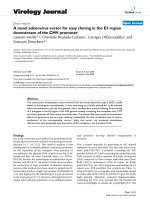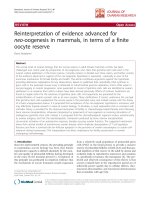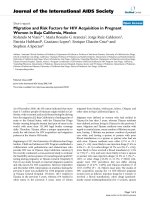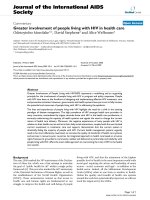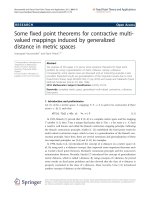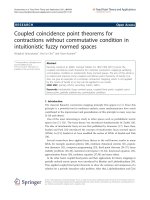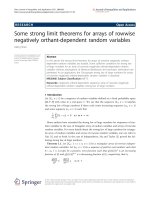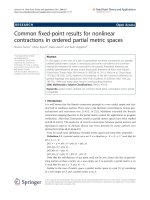Báo cáo hóa học: " Another weak convergence theorems for accretive mappings in banach spaces" pot
Bạn đang xem bản rút gọn của tài liệu. Xem và tải ngay bản đầy đủ của tài liệu tại đây (308.04 KB, 11 trang )
RESEARC H Open Access
Another weak convergence theorems for
accretive mappings in banach spaces
Satit Saejung
*
, Kanokwan Wongchan and Pongsakorn Yotkaew
* Correspondence:
th
Department of Mathematics,
Faculty of Science, Khon kaen
University, Khon kaen 40002,
Thailand
Abstract
We present two weak convergence the orems for inverse strongly accretive mappings
in Banach spaces, which are supplements to the recen t result of Aoyama et al. [Fixed
Point Theory Appl. (2006), Art. ID 35390, 13pp.].
2000 MSC: 47H10; 47J25.
Keywords: weak convergence theorem, accretive mapping, Banach space
1. Introduction
Let E be a real B anach space with the dual space E*. We write 〈 x, x* 〉 for the value of a
functional x*Î E *atx Î E. The normalized duality mapping is the mapping J : E ® 2 E*
given by
Jx = {x
∗
∈ E
∗
: x, x
∗
= ||x||
2
= ||x
∗
||
2
}
(
x ∈ E
).
In this paper, we assume that E is smooth,thatis,
lim
t→0
||x+tx||−||x||
t
exists for all x, y
Î E with ||x|| = ||y|| = 1. This implies that J is single-valued and we do consider the
singleton Jx as an element in E*. For a closed convex subset C of a (smooth) Banach
space E, the variational inequality problem for a mapping A : C ® E is the problem of
finding an element u Î C such that
Au, J
(
v − u
)
≥0forallv ∈ C
.
The set of solutions of the problem above is denoted by S(C, A ). It is noted that if
C = E,thenS(C, A)=A
-1
0:={x Î E : Ax = 0}. This problem was studied by Stampac-
chia (see, for example, [1,2]). The applicability of the theory has been expanded to var-
ious problems from economics, finance, optimization and game theory.
Gol’shteĭnandTret’yakov [3] proved the following result in the finite dimensional
space ℝ
N
.
Theorem 1.1. Let a >0,and let A : ℝ
N
® ℝ
N
be an a-inverse strongly monotone
mapping, that is, 〈Ax - Ay, × - y〉 ≥ a||Ax - Ay||
2
for all x, y Î ℝ
N
. Suppose that {x
n
} is
a sequence in ℝ
N
defined iteratively by x
1
Î ℝ
N
and
x
n
+1
= x
n
− λ
n
Ax
n
,
where {l
n
}⊂ [a, b] ⊂ (0, 2a). If A
-1
0 ≠ ∅, then {x
n
} converges to some element of A
-1
0.
The result above was generalized to the framework of Hilbert spaces by Iiduka et al. [4].
Note that every Hilbert space is uniformly convex and 2-uniformly smooth (the r elat ed
Saejung et al. Fixed Point Theory and Applications 2011, 2011:26
/>© 2011 Saejung et al; licensee Springer . This is an Open Access article distributed under the terms of the Creative Commons
Attribution License ( which permits unrestricted use, distribution, and reproduction in
any medium, provided the original work is properly cited.
definitions will be given in the next section). Aoyama et al. [[5], Theorem 3.1] proved the
following result.
Theorem 1.2. Let E be a uniformly convex and 2-uniformly smooth Banach space
with the uniform smoothness constant K, and let C be a nonempty closed convex subset
of E. Let Q
C
be a sunny nonexpansive retraction from E onto C, let a >0andletA:
C ® Ebeana-inverse strongly accretive mapping with S(C, A) ≠ ∅. Suppose that {x
n
}
is iteratively defined by
x
1
∈ C arbitrarily chosen,
x
n+1
= α
n
x
n
+(1− α
n
)Q
C
(x
n
− λ
n
Ax
n
)(n ≥ 1)
,
where {a
n
} ⊂ [b, c] ⊂ (0, 1) and {l
n
} ⊂ [a, a/K
2
] ⊂ (0, a/K
2
]. Then,{x
n
} converges
weakly to some element of S(C, A).
Motiv ated by the result of Aoyama et al., we prove two more convergence theorems
for a-inverse strongly accretive mappings in a Banach space, which are supplements to
Theore m 1.2 above. The first one is proved without the prese nce of the uniform con-
vexity, while the last one is proved in uniformly convex space with some different con-
trol conditions on the parameters.
The paper is organized as follows: In Section 2, we collect some related definitions
and known fact, which are referred in this paper. The main results are presented in
Section 3. We start with some common tools in proving the main r esults in Section
3.1. In Section 3.2, we prove the first weak convergence theorem without the presence
of uniform convexity. The second theorem is proved in uniformly convex Banach
spaces in Section 3.3.
2. Definitions and related known fact
Let E be a real Banach space. If {x
n
} is a sequence in E,wedenotestrong convergence
of {x
n
}tox Î E by x
n
® x and weak convergence by x
n
⇀ x.Denotebyω
w
({x
n
}) the
set of weakly sequential limits of the sequence {x
n
}, th at is, ω
w
({x
n
}) = {p : there exists
a subsequence
{x
n
k
}
of {x
n
}suchthat
x
n
k
p
}. It is known that if {x
n
} is a bounded
sequence in a reflexive space, then ω
w
({x
n
}) = ∅.
The space E is said to be uniformly convex if for each ε Î (0, 2) there exists δ >0
such that for any x, y Î U := {z Î E :||z|| = 1}
|
|x −
y
|| ≥ ε implies ||x +
y
||
/
2 ≤ 1 − δ
.
The following result was proved by Xu.
Lemma 2.1 ([6]). Let E be a uniformly convex Banach space, and let r >0. Then,
there exists a strictly increasing, continuous and convex function g :[0,2r] ® [0, ∞)
such that g(0) = 0 and
|
|αx +
(
1 − α
)
y||
2
≤ α||x||
2
+
(
1 − α
)
||y||
2
− α
(
1 − α
)
g
(
||x − y||
)
for all a Î [0, 1] and x, y Î B
r
:= {z Î E :||z|| ≤ r}.
The space E is said to be smooth if the limit
lim
t→0
||x + ty|| − ||x||
t
(2:1)
exists for all x, y Î U. The norm of E is said to be Fréchet differentiable if for each x
Î U, the limit (2.1) is attained uniformly for y Î U.
Saejung et al. Fixed Point Theory and Applications 2011, 2011:26
/>Page 2 of 11
Let C be a nonempty subset of a smooth Banach space E and a >0.AmappingA :
C ® E is said to be a-inverse strongly accretive if
Ax − Ay, J
(
x − y
)
≥α||Ax − Ay||
2
(2:2)
for all x, y Î C. It follows from (2.2) that A is
1
α
-Lipschitzian, that is,
|
|Ax − Ay|| ≤
1
α
||x − y|| for all x, y ∈ C
.
A Banach space E is 2-uniformly smooth if there is a constant c > 0 such that 〉
E
(τ) ≤
cτ
2
for all τ > 0 where
E
(τ )=sup
1
2
(||x + τy|| + ||x − τ y||) − 1:x, y ∈ U
.
In this case, we say that a real number K > 0 is a 2-uniform smoothness constant of E
if the following inequality holds for all x, y Î E:
|
|x +
y
||
2
≤||x||
2
+2
y
, Jx +2||K
y
||
2
.
Note that every 2-uniformly smooth Banach space has the Fréchet differentiable
norm and hence it is reflexive.
The following observation extracted from Lemma 2.8 of [5] plays an important role
in this paper.
Lemma 2.2. Let C be a nonempty closed convex subset of a 2-uniformly smooth
Banach space E with a 2-uniform smoothness constant K. Suppose that A : C ® Eis
an a-inverse strongly accretive mapping. Then, the following inequality holds for all x, y
Î C and l Î ℝ:
|
|
(
I − λA
)
x −
(
I − λA
)
y||
2
≤||x − y||
2
+2λ
(
K
2
λ − α
)
||Ax − Ay||
2
,
where I is the identity mapping. In particular, if
λ ∈ [0,
α
K
2
]
, then I - lA is nonex pan-
sive, that is, ||(I - lA)x -(I - lA)y|| ≤ ||x - y|| for all x, y Î C.
Let C be a subset of a Banach space E. A mapping Q : E ® C is said to be:
(i) sunny if Q(Qx + t(x - Qx)) = Qx for all t ≥ 0;
(ii) a retraction if Q
2
= Q.
It is known that a retraction Q fromasmoothBanachspaceE o nto a nonempt y
closed convex subset C of E is sunny and nonexpansive if and only if 〈x-Qx, J(Qx-y)〉 ≥
0forallx Î E and y Î C. In this case, Q is uniquely determined. Using this result,
Aoya ma et al. obtained the following result. Recall that, for a mapping T : C ® E,the
set of fixed points of T is denoted by F (T), that is, F (T)={x Î C : x = Tx}.
Lemma 2.3 ([5]). Let C be a nonempty closed convex subset of a smooth Banach
space
E. Let Q
C
be a sunny nonexpansive retraction from E onto C, and let A : C ® Ebea
mapping. Then, for each l >0,
S
(
C, A
)
= F
(
Q
C
(
I − λA
)).
Saejung et al. Fixed Point Theory and Applications 2011, 2011:26
/>Page 3 of 11
The space E is said to satisfy Opial’s condition if
lim sup
n
→∞
||x
n
− x|| < lim sup
n
→∞
||x
n
− y|
|
whenever x
n
⇀ x Î E and y Î E satisfy x ≠ y. The follow ing results are known from
theory of nonexpansive mappings. It should be noted that Oplial’s condition and the
Fréchet differentiability of the norm are independent in uniformly convex space
setting.
Lemma 2.4 ([7], [8]). Let C be a nonempty closed convex subset of a Banach space. E.
Suppose that E is uniformly convex or satisfies Opial’s condition. Suppose that T is a
nonexpansive map ping of C into itself. Then, I - T is demiclosed at zero, that is, if {x
n
}
is a sequence in C such that x
n
⇀ p and x
n
- Tx
n
® 0, then p = Tp.
Lemma 2.5 ([9]). Let C be a nonempty closed convex subset of a uniformly convex
Banach space with a Fréchet differentiab le norm. Suppose that
{T
n
}
∞
n
=
1
is a sequence of
nonexpansive mappings of C into itself with
∩
∞
n
=1
F( T
n
) =
∅
. Let x Î C and S
n
= T
n
T
n-1
·
··T
1
for all n ≥ 1. Then, the set
∞
n
=1
co{S
m
x : m ≥ n}∩
∞
n
=1
F( T
n
)
consists of at most one element, where
co
D is the closed convex hull of D.
The following two lemmas are prov ed in the absence of uniform convexity, and they
are needed in Section 3.2.
Lemma 2.6 ([10]). Let {x
n
} and {y
n
} be bounded sequences in a Banach space and
{a
n
} be a real sequence in [0, 1] such that 0<liminf
n®∞
a
n
≤ lim sup
n®∞
a
n
<1.
Suppose that x
n+1
= a
n
x
n
+(1-a
n
)y
n
for all n ≥ 1. If lim sup
n®∞
(||y
n+1
- y
n
|| - ||x
n+1
- x
n
||) ≤ 0, then x
n
- y
n
® 0.
Lemma 2.7 ([11]). Let {z
n
} and {w
n
} be sequences in a Banach space and {a
n
} be a
real sequence in [0, 1]. Suppose that z
n+1
= a
n
z
n
+(1-a
n
)w
n
for all n ≥ 1. If the follow-
ing properties are satisfied:
(i)
∞
n
=1
(1 − α
n
)=
∞
and lim inf
n®∞
a
n
>0;
(ii) lim
n®∞
||z
n
|| = d and lim sup
n®∞
||w
n
|| ≤ d;
(iii) the sequence
n
i=1
(1 − α
i
)w
i
is bounded;
then d =0.
We also need the following simple but interesting results.
Lemma 2.8 ([12]). Let {a
n
} and {b
n
} be two sequences of nonnegative real numbers.
If
∞
n
=1
b
n
<
∞
and a
n+1
≤ a
n
+ b
n
for all n ≥ 1, then lim
n®∞
a
n
exists.
Lemma 2.9 ([13]). Let {a
n
} and {b
n
} be two sequences of nonnegative real numbers. If
∞
n=1
a
n
b
n
<
∞
and
∞
n=1
a
n
b
n
<
∞
, then lim inf
n®∞
b
n
=0.
3. Main results
From now on, we assume that
• E is 2-uniformly smooth Banach space with a 2-uniform smoothness constant K;
Saejung et al. Fixed Point Theory and Applications 2011, 2011:26
/>Page 4 of 11
• C is a nonempty closed convex subset of E;
• Q
C
is a sunny nonexpansive retraction from E onto C;
• A : C ® E is an a-inverse strongly accretive mapping with S(C, A) ≠ ∅ and a >
0.
Suppose that {x
n
} is iteratively defined by
x
1
∈ C arbitrarily chosen,
x
n+1
= α
n
x
n
+(1− α
n
)Q
C
(x
n
− λ
n
Ax
n
)(n ≥ 1)
,
where {a
n
} ⊂ [0, 1] and
{λ
n
}⊂(0,
α
K
2
]
. For convenience, we write y
n
≡ Q
C
( x
n
- l
n
Ax
n
).
3.1. Some properties of the sequence {x
n
} for weak convergence theorems
We star t with some propositions, which are the common tools for proving the main
results in the next two subsections.
Proposition 3.1. If p Î S(C, A), then lim
n® ∞
||x
n
- p|| exists, and hence, the
sequences {x
n
} and {Ax
n
} are both bounded.
Proof. Let p Î S(C, A). By the nonexpansiveness of Q
C
(I - l
n
A) for all n ≥ 1 and
Lemma 2.3, we have
|
|y
n
− p|| = ||Q
C
(
I − λ
n
A
)
x
n
−
(
Q
C
(
I − λ
n
A
)
p|| ≤ ||x
n
− p|
|
for all n ≥ 1. This implies that
||x
n+1
− p|| = ||α
n
(x
n
− p)+(1− α
n
)(y
n
− p)||
≤ α
n
||x
n
− p|| +(1− α
n
)||y
n
− p||
≤ α
n
||x
n
− p|| +
(
1 − α
n
)
||x
n
− p|| = ||x
n
− p|
|
for all n ≥ 1. Therefore, lim
n®∞
||x
n
- p|| exists, and hence, the sequence {x
n
}is
bounded. Since A is
1
α
-Lipschitzian, we have {Ax
n
} is bounded. The proof is finished.
Proposition 3.2. The following inequality holds:
|
|
y
n+1
−
y
n
|| ≤ ||x
n+1
− x
n
|| + |λ
n+1
− λ
n
|||Ax
n
|
|
for all n ≥ 1.
Proof. Since Q
C
(I - l
n+1
A) and Q
C
are nonexpansive, we have
|
|y
n+1
− y
n
|| = ||Q
C
(I − λ
n+1
A)x
n+1
− Q
C
(I − λ
n
A)x
n
||
≤||Q
C
(I − λ
n+1
A)x
n+1
− Q
C
(I − λ
n+1
A)x
n
||
+ ||Q
C
(I − λ
n+1
A)x
n
− Q
C
(I − λ
n
A)x
n
||
≤||x
n+1
− x
n
|| + ||(I − λ
n+1
A)x
n
− (I − λ
n
A)x
n
|
|
=
||
x
n+1
− x
n
||
+
|
λ
n+1
− λ
n
|||
Ax
n
||
.
□
Proposition 3.3. Suppose that E is a reflexive Banach space such that either it is uni-
formly convex or it satisfies Opial’s condition. Suppose that {x
n
} is a bounded sequence
of C satisfying x
n
- Q
C
(I - l
n
A)x
n
® 0 and
{λ
n
}⊂[a,
α
K
2
] ⊂ (0,
α
K
2
]
.
Then,{x
n
} converges weakly to some element of S(C, A).
Saejung et al. Fixed Point Theory and Applications 2011, 2011:26
/>Page 5 of 11
Proof. Suppose that E is a uniformly convex Banach space or a reflexive Banach space
satisfying Opial’s condition. Then, ω
w
({x
n
}) ≠ ∅.Wefirstprovethatω
w
({x
n
}) ⊂ S(C,
A). To see this, let z Î ω
w
({x
n
}). Passing to a subsequence, if necessary, we assume that
there exists a subsequence {n
k
}of{n} such that
x
n
k
z
and
λ
n
k
→ λ ∈ [a,
α
K
2
]
.We
observe that
|
|x
n
k
− Q
C
(I − λA)x
n
k
|| ≤ ||x
n
k
− y
n
k
|| + ||y
n
k
− Q
C
(I − λA)x
n
k
||
≤||x
n
k
− y
n
k
|| + ||(I − λ
n
k
A)x
n
k
− (I − λA)x
n
k
||
= ||x
n
k
− y
n
k
|| + |λ
n
k
− λ|||Ax
n
k
||.
This implies that
x
n
k
− Q
C
(
I − λA
)
x
n
k
→
0
. By the nonexpansiveness of Q
C
(I - lA),
Lemmas 2.3 and 2.4, we obtain that z Î F ( Q
C
(I - lA)) = S(C, A). Hence ω
w
({x
n
}) ⊂ S
(C, A).
We next prove that ω
w
({x
n
}) is exactly a singleton in the following cases.
Case 1: E is uniformly convex. We follow the idea of A oyama et al. [5] in this case.
For any n ≥ 1, we define a nonexpansive mapping T
n
: C ® C by
T
n
= α
n
I +
(
1 − α
n
)
Q
C
(
I − λ
n
A
).
We get t hat x
n+1
= T
n
T
n-1
···T
1
x
1
for all n ≥ 1. It follows from Lemma 2.3 that
S(C, A)=
∞
n
=1
F( Q
C
(I − λ
n
A)) ⊂
∞
n
=1
F( T
n
)
. Applying Lemma 2.5, since every 2-uni-
formly smooth Banach space has Fréchet differentiable norm, gives
∞
n
=1
co{x
m
: m ≥ n}∩
∞
n
=1
F( T
n
)
consists of at most one element. But we know that
∅ = ω
w
({x
n
}) ⊂
∞
n
=1
co {x
m
: m ≥ n}∩S(C, A) ⊂
∞
n
=1
co {x
m
: m ≥ n}∩
∞
n
=1
F(T
n
)
.
Therefore, ω
w
({x
n
}) is a singleton.
Case 2: E satisfies Opial’s condition. Suppose that p and q are two different elements
of ω
w
({x
n
}). There are subsequences
{x
n
k
}
and
{
x
m
j
}
of {x
n
} such that
x
n
k
p and x
m
j
q
.
Since p and q also belong to S(C, A), both limits lim
n®∞
||x
n
-p|| and lim
n®∞
||x
n
-q|| exist. Consequently, by Opial ’s condition,
lim
k→∞
||x
n
k
− p|| < lim
k→∞
||x
n
k
− q|| = lim
j→∞
||x
m
j
− q||
< lim
j
→∞
||x
m
j
− p|| = lim
k→∞
||x
n
k
− p||
.
This is a contradiction. Hence, ω
w
({x
n
}) is a singleton, and the proof is finished. □
Remark 3.4. There exists a reflexive Banach space such that it satisfies Opial’s condi-
tion but it is not uniformly convex. In fact, we consider E = ℝ
2
with the norm ||(x, y)||
=|x|+|y|forall(x, y) Î ℝ
2
. Note that E is finite dimensional, and hence it is reflex-
ive and satisfies Opial’s condition. To see that E is not uniformly convex, let x =(1,0)
and y = (0, 1), it follows that ||x - y|| = ||(1, -1)|| = 2 and ||x + y||/2 = ||(1/2, 1/2)|| =
1 ≰ 1-δ for all δ >0.
Saejung et al. Fixed Point Theory and Applications 2011, 2011:26
/>Page 6 of 11
3.2. Convergence results without uniform convexity
In this subsection, we make use of Lemmas 2.6 and 2.7 to show that x
n
- y
n
® 0 under
the additional restrictions on the sequences {a
n
} and {l
n
}.
Proposition 3.5. Suppose that {a
n
}⊂ [c, d] ⊂ (0, 1) and l
n+1
- l
n
® 0. Then, x
n
- y
n
® 0.
Proof. We will apply Lemma 2.6. Let us rewritten the iteration as
x
n+1
= α
n
x
n
+
(
1 − α
n
)
y
n
.
It follows from Proposition 3.1 that {x
n
}and{Ax
n
} are bounded. Then, {y
n
}={(I -
l
n
A) x
n
} is bounded. Since l
n+1
- l
n
® 0, it is a consequence of Proposition 3.2 that
lim sup
n
→∞
(||y
n+1
− y
n
|| − ||x
n+1
− x
n
||) ≤ lim sup
n
→∞
|λ
n+1
− λ
n
|||Ax
n
|| =0
.
Since all the requirements of Lemma 2.6 are satisfied, x
n
- y
n
® 0. □
Proposition 3.6. Suppose that {a
n
} and {l
n
} satisfy the following properties:
(i) {a
n
} ⊂ [c,1)⊂ (0, 1) and
∞
n
=1
(1 − α
n
)=
∞
;
(ii)
λ
n+1
−
λ
n
1 − α
n
→ 0
and
∞
n
=1
| λ
n+1
− λ
n
| <
∞
.
Then, x
n
- y
n
® 0.
Proof. We will apply Lemma 2.7. From the iteration, we have
z
n+1
= α
n
z
n
+
(
1 − α
n
)
w
n
,
where z
n
≡ x
n
- y
n
and
w
n
≡
y
n
− y
n+1
1 − α
n
. Using Proposition 3.2, we obtain
||
z
n+1
||
≤ α
n
||
z
n
||
+
||
y
n
− y
n+1
||
≤ α
n
||z
n
|| + ||x
n+1
− x
n
|| + |λ
n+1
− λ
n
|||Ax
n
||
= α
n
||z
n
|| +(1− α
n
)||z
n
|| + |λ
n+1
− λ
n
|||Ax
n
|
|
= ||z
n
|| + |λ
n+1
− λ
n
|||Ax
n
||.
It follows from
∞
n
=1
| λ
n+1
− λ
n
|||Ax
n
|| <
∞
and Lemma 2.8 that d := lim
n®∞
||z
n
||
exists. We next prove that lim sup
n®∞
||w
n
|| ≤ d. Again, by Proposition 3.2, we get
lim sup
n→∞
||w
n
|| = lim sup
n→∞
||
y
n
− y
n+1
||
1 − α
n
≤ lim
n→∞
||z
n
|| + lim sup
n→∞
|λ
n+1
− λ
n
|
1 − α
n
||Ax
n
|| = d
.
Finally, for all n ≥ 1, we have
n
i
=1
(1 − α
i
)w
i
=
n
i
=1
(y
i
− y
i+1
)=y
1
− y
n+1
.
Hence, the sequence
n
i=1
(1 − α
i
)w
i
is bounded. It follows then that d =0.□
We now have the following weak convergence theorems without uniform convexity.
Theorem 3.7. Let E be a 2-uniformly smooth Banach space satisfying Opial’s condi-
tion. Let C be a nonempty closed convex subset of E. L et Q
C
be a sunny n onexpansive
retraction from E onto C and A : C ® Ebeana-inverse strongly accretive mapping
with S(C, A) ≠ ∅ and a >0.Suppose that {x
n
} is iteratively defined by
Saejung et al. Fixed Point Theory and Applications 2011, 2011:26
/>Page 7 of 11
x
1
∈ C arbitrarily chosen,
x
n+1
= α
n
x
n
+(1− α
n
)Q
C
(x
n
− λ
n
Ax
n
)(n ≥ 1)
,
where {a
n
} ⊂ [0, 1] and
{λ
n
}⊂[a,
α
K
2
] ⊂ (0,
α
K
2
]
satisfy one of the following condi-
tions:
(i) {a
n
} ⊂ [c, d] ⊂ (0, 1) and l
n+1
- l
n
® 0;
(ii) {a
n
} ⊂ [c,1)⊂ (0, 1),
∞
n
=1
(1 − α
n
)=
∞
,
∞
n
=1
| λ
n+1
− λ
n
| <
∞
, and
λ
n+1
−
λ
n
1 − α
n
→
0
.
Then,{x
n
} converges weakly to an element in S(C, A).
Proof. Note that every 2-uniformly smooth Banach space is reflexive. The result fol-
lows from Propositions 3.3, 3.5 and 3.6. □
Remark 3.8. Conditions (i) and (ii) in Theorem 3.7 are not comparable.
(1) If
α
n
≡
1
2
and {l
n
}isasequencein
(0,
α
K
2
]
such that l
n
- l
n+1
® 0 an d 0 < lim
inf
n®∞
l
n
< lim sup
n®∞
l
n
< 1, then {a
n
} and {l
n
} satisfy condition (i) but fail con-
dition (ii).
(2) If
α
n
≡
n
n
+1
and
λ
n
≡ λ ∈ (0,
α
K
2
]
, then {a
n
} and {l
n
} satisfy co ndition (ii) but fail
condition (i).
Remark 3.9. Note that the Opial property and uniform convexity are independent.
Theorem 3.7 is a supplementary to Theorem 3.1 of Aoyama et al. [5].
3.3. Convergence results in uniformly convex spaces
In this subsection, we prove two more convergence theorems in uniformly convex
spaces, which are also a supplementary to Theorem 3.1 of Aoyama et al. [5]. Let us
start with some propositions.
Proposition 3.10. Assume t hat E is a uniformly convex Banach space. Suppose that
{a
n
} and {l
n
} satisfy the following properties:
(i) {l
n
} ⊂ [a, a/K
2
] ⊂ (0, a/K
2
];
(ii)
∞
n
=1
α
n
(1 − α
n
)=
∞
and
∞
n
=1
| λ
n+1
− λ
n
| <
∞
.
Then, x
n
- y
n
® 0.
Proof.Letp Î S(C, A). Note that lim
n®∞
||x
n
- p|| exists and hence both {x
n
}and
{y
n
} are bounded. By the uniform convexity of E and Lemma 2.1, there exists a contin-
uous and strictly increasing function g such that
|
|x
n+1
− p||
2
= ||α
n
(x
n
− p)+(1− α
n
)(y
n
− p)||
2
≤ α
n
||x
n
− p||
2
+(1− α
n
)||y
n
− p||
2
− α
n
(1 − α
n
)g(||x
n
− y
n
||)
≤ α
n
||x
n
− p||
2
+(1− α
n
)||x
n
− p||
2
− α
n
(1 − α
n
)g(||x
n
− y
n
||
)
= ||x
n
− p||
2
− α
n
(
1 − α
n
)
g
(
||x
n
− y
n
||
)
Saejung et al. Fixed Point Theory and Applications 2011, 2011:26
/>Page 8 of 11
for all n ≥ 1. Hence, for each m ≥ 1, we have
m
n=1
α
n
(1 − α
n
)g(||x
n
− y
n
||) ≤||x
1
− p||
2
−||x
m+1
− p||
2
.
In particular,
∞
n
=1
α
n
(1 − α
n
)g(||x
n
− y
n
||) <
∞
. It follows from
∞
n
=1
α
n
(1 − α
n
)=
∞
andLemma2.9thatliminf
n®∞
g(||x
n
- y
n
||) = 0. By the prop-
erties of the function g, we get that lim inf
n®∞
||x
n
- y
n
|| = 0. Finally, we show that
lim
n®∞
||x
n
- y
n
|| actually exists. To see this, we consider the following estimate
obtained directly from Proposition 3.2:
|
|x
n+1
− y
n+1
|| ≤ ||x
n+1
− y
n
|| + ||y
n
− y
n+1
||
≤ α
n
||x
n
− y
n
|| + ||x
n+1
− x
n
|| + |λ
n+1
− λ
n
|||Ax
n
||
= α
n
||x
n
− y
n
|| +(1− α
n
)||x
n
− y
n
|| + |λ
n+1
− λ
n
|||Ax
n
|
|
= ||x
n
−
y
n
|| + |λ
n+1
− λ
n
|||Ax
n
||.
The assertion follows since
∞
n
=1
|λ
n
− λ
n+1
|||Ax
n
|| <
∞
and Lemma 2.8. □
Let us recall the concept of strongly nonexpansive sequences introduced by Aoyama
et al. (see [14]). A sequence of nonexpansive mappings {T
n
}ofC is called a strongly
nonexpansive sequence if x
n
- y
n
-(T
n
x
n
- T
n
y
n
) ® 0whenever{x
n
}and{y
n
}are
sequences in C such that {x
n
-y
n
} is bounded and ||x
n
-y
n
||-||T
n
x
n
-T
n
y
n
|| ® 0. It is
notedthatif{T
n
} is a constant sequence, then this property reduces to the concept of
strongly nonexpansive mappings studied by Bruck and Reich [15].
Proposition 3.11. Assume that E is a uniformly convex B anach space and {l
n
}⊂ (0,
b] ⊂ (0, a/K
2
). Then,{Q
C
(I - l
n
A)} is a strongly nonexpansive sequence.
Proof. Notice first that Q
C
is a strongly nonexpansive mapping (see [16,17]). Next, we
prove that {I - l
n
A} is a strongly nonexpansive sequence and then the assertion fol-
lows. Let {x
n
} and {y
n
} be sequences in C such that {x
n
- y
n
} is bounded and ||x
n
- y
n
||-
||(I - l
n
A)x
n
-(I - l
n
A)y
n
|| ® 0. It follows from Lemma 2.2 that
2(α − K
2
b)
b
||λ
n
Ax
n
− λ
n
Ay
n
||
2
≤
2(α − K
2
λ
n
)
λ
n
||λ
n
Ax
n
− λ
n
Ay
n
||
2
=2λ
n
(α − K
2
λ
n
)||Ax
n
− Ay
n
||
2
≤||x
n
− y
n
||
2
−||
(
I − λ
n
A
)
x
n
−
(
I − λ
n
A
)
y
n
||
2
→ 0
.
In particular, l
n
Ax
n
- l
n
Ay
n
® 0 and hence
x
n
− y
n
−
((
I − λ
n
A
)
x
n
−
(
I − λ
n
A
)
y
n
)
= λ
n
Ax
n
− λ
n
Ay
n
→ 0
.
Proposition 3.12. Assume t hat E is a uniformly convex Banach space. Suppose that
a
n
≡ 0 and {l
n
} ⊂ (0, b] ⊂ (0, a/K
2
). Then, x
n
- y
n
® 0.
Proof. Let us rewritten the iteration as follows:
x
n+1
= Q
C
(
I − λ
n
A
)
x
n
(
n ≥ 1
).
Let p Î S(C, A). Notice that p = Q
C
(I -l
n
A)p for all n ≥ 1. Then, lim
n®∞
||x
n
-p||
exists, and hence,
Saejung et al. Fixed Point Theory and Applications 2011, 2011:26
/>Page 9 of 11
|
|x
n
− p|| − ||Q
C
(
I − λ
n
A
)
x
n
− p|| = ||x
n
− p|| − ||x
n+1
− p|| → 0
.
It follows from the preceding proposition that
x
n
− Q
C
(
I − λ
n
A
)
x
n
=
(
x
n
− p
)
−
(
Q
C
(
I − λ
n
A
)
x
n
− p
)
→ 0
.
□
We now obtain the fo llowing weak conv ergence theorems in uniforml y convex
spaces.
Theorem 3.13. Let E be a uniformly convex and 2-uniformly smooth Banach space.
Let C be a nonempty closed convex subset of E. Let Q
C
be a sunny nonexpansive retrac -
tion from E onto C and A : C ® Ebeana-inverse strongly accretive mapping with S
(C, A) ≠ ∅ and a >0.Suppose that {x
n
} is iteratively defined by
x
1
∈ C arbitrarily chosen,
x
n+1
= α
n
x
n
+(1− α
n
)Q
C
(x
n
− λ
n
Ax
n
)(n ≥ 1)
,
where {a
n
} ⊂ [0, 1] and
{λ
n
}⊂[a,
α
K
2
] ⊂ (0,
α
K
2
]
satisfy one of the following condi-
tions:
(i)
∞
n
=1
α
n
(1 − α
n
)=
∞
and
∞
n
=1
| λ
n+1
− λ
n
| <
∞
;
(ii) a
n
≡ 0 and {l
n
}⊂ [a, b] ⊂ (0, a/K
2
).
Then,{x
n
} converges weakly to an element in S (C, A).
Proof. The result follows from Propositions 3.3, 3.10 and 3.12. □
Remark 3.14. It is easy to see that conditions (i) and (ii) in Theorem 3.13 are not
comparable.
Remark 3.15. Compare Theorem 3.13 to Theorem 1.2 of Aoyama et al., our result is
a supplementary to their result. It is noted that, for example, our iteration scheme with
a
n
≡ 0 and l
n
≡ a/(a/K
2
) is simpler than the one in Theorem 1.2.
Acknowledgements
The first author is supported by the Thailand Research Fund, the Commission on Higher Education of Thailand and
Khon Kaen University under Grant number 5380039. The second author is supported by gran t fun d under the
program Strategic Scholarships for Frontier Research Network for the Ph.D. Program Thai Doctoral degree from the
Office of the Higher Education Commission, Thailand. The third author is supported by the Thailand Research Fund
through the Royal Golden Jubilee Ph.D. Program (Grant No. PHD/0188/2552) and Khon Kaen University under the
RGJ–Ph.D. scholarship. Finally, the authors thank Professor M. de la Sen and the referees for their comments and
suggestions.
Authors’ contributions
All authors contribute equally and significantly in this research work. All authors read and approved the final
manuscript.
Competing interests
The authors declare that they have no competing interests.
Received: 15 November 2010 Accepted: 8 August 2011 Published: 8 August 2011
References
1. Kinderlehrer, D, Stampacchia, G: An introduction to variational inequalities and their applications. In Pure and Applied
Mathematics, vol. 88,Academic Press, Inc., New York (1980). xiv+313
2. Lions, J-L, Stampacchia, G: Variational inequalities. Comm Pure Appl Math. 20, 493–519 (1967). doi:10.1002/
cpa.3160200302
Saejung et al. Fixed Point Theory and Applications 2011, 2011:26
/>Page 10 of 11
3. Gol’shteĭn, EG, Tret’yakov, NV: Modified Lagrangians in convex programming and their generalizations. Point-to-set
maps and mathematical programming. Math Programming Stud. 10,86–97 (1979)
4. Iiduka, H, Takahashi, W, Toyoda, M: Approximation of solutions of variational inequalities for monotone mappings.
Panamer Math J. 14,49–61 (2004)
5. Aoyama, K, Iiduka, H, Takahashi, W: Weak convergence of an iterative sequence for accretive operators in Banach
spaces. Fixed Point Theory Appl Art 2006, 13 (2006). ID 35390
6. Xu, HK: Inequalities in Banach spaces with applications. Nonlinear Anal. 16, 1127–1138 (1991). doi:10.1016/0362-546X(91)
90200-K
7. Browder, FE: Nonlinear operators and nonlinear equations of evolution in Banach spaces. Nonlinear functional analysis.
Proceedings of Symposia in Pure Mathematics, vol. XVIII, Part 2, Chicago, IL, 1968, pp. 1-308. American Mathematical
Society, Providence (1976)
8. Opial, Z: Weak convergence of the sequence of successive approximations for nonexpansive mappings. Bull Am Math
Soc. 73, 591–597 (1967). doi:10.1090/S0002-9904-1967-11761-0
9. Reich, S: Weak convergence theorems for nonexpansive mappings in Banach spaces. J Math Anal Appl. 67, 274–276
(1979). doi:10.1016/0022-247X(79)90024-6
10. Suzuki, T: Strong convergence theorems for infinite families of nonexpansive mappings in general Banach spaces. Fixed
Point Theory Appl. 2005, 103–123 (2005). doi:10.1155/FPTA.2005.103
11. Deng, L: Convergence of the Ishikawa iteration process for nonexpansive mappings. J Math Anal Appl. 199, 769–775
(1996). doi:10.1006/jmaa.1996.0174
12. Tan, K-K, Xu, HK: Approximating fixed points of nonexpansive mappings by the Ishikawa iteration process. J Math Anal
Appl. 178, 301–308 (1993). doi:10.1006/jmaa.1993.1309
13. Ofoedu, EU: Strong convergence theorem for uniformly L-Lipschitzian asymptotically pseudo-contractive mapping in
real Banach space. J Math Anal Appl. 321, 722–728 (2006). doi:10.1016/j.jmaa.2005.08.076
14. Aoyama, K, Kimura, Y, Takahashi, W, Toyoda, M: On a strongly nonexpansive sequence in Hilbert spaces. J Nonlinear
Convex Anal. 8, 471–489 (2007)
15. Bruck, RE, Reich, S: Nonexpansive projections and resolvents of accretive operators in Banach spaces. Houston J Math.
3, 459–470 (1977)
16. Kitahara, S, Takahashi, W: Image recovery by convex combinations of sunny nonexpansive retractions. Topol Methods
Nonlinear Anal. 2, 333–342 (1993)
17. Reich, S: A limit theorem for projections. Linear Multilinear Algebra. 13, 281–290 (1983). doi:10.1080/03081088308817526
doi:10.1186/1687-1812-2011-26
Cite this article as: Saejung et al.: Another weak convergence theorems for accretive mappings in banach
spaces. Fixed Point Theory and Applications 2011 2011:26.
Submit your manuscript to a
journal and benefi t from:
7 Convenient online submission
7 Rigorous peer review
7 Immediate publication on acceptance
7 Open access: articles freely available online
7 High visibility within the fi eld
7 Retaining the copyright to your article
Submit your next manuscript at 7 springeropen.com
Saejung et al. Fixed Point Theory and Applications 2011, 2011:26
/>Page 11 of 11
